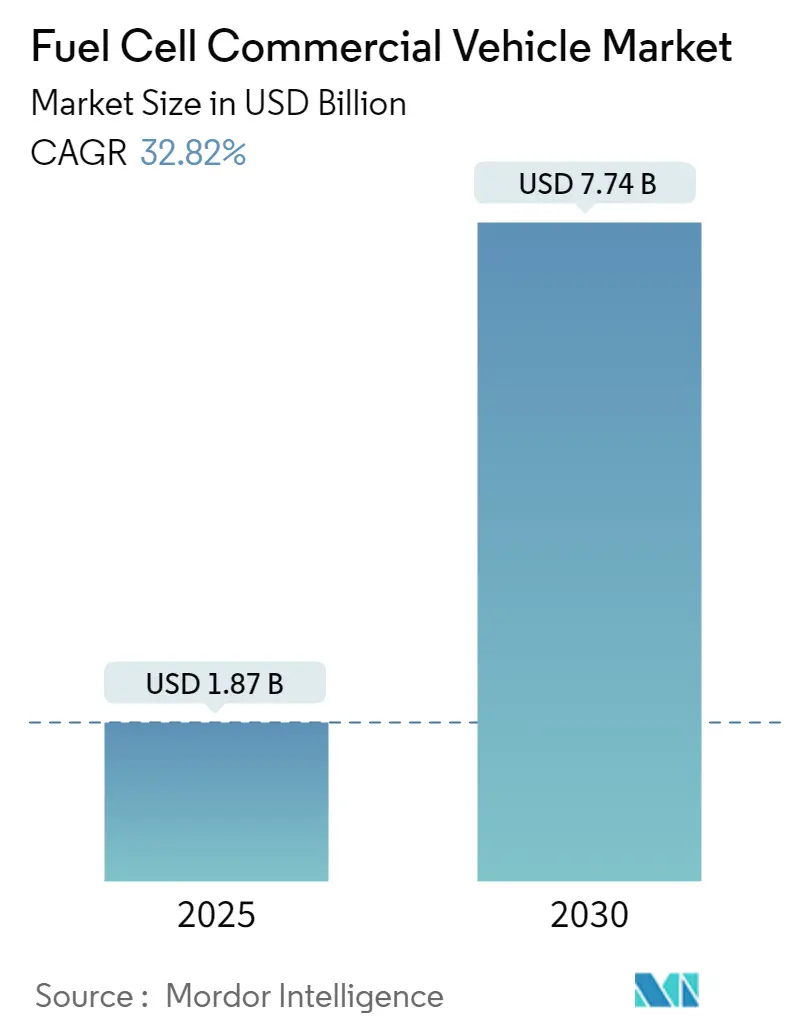
| Study Period | 2019 - 2030 |
| Market Size (2025) | USD 1.87 Billion |
| Market Size (2030) | USD 7.74 Billion |
| CAGR (2025 - 2030) | 32.82 % |
| Fastest Growing Market | Asia-Pacific |
| Largest Market | Asia-Pacific |
| Market Concentration | Medium |
Major Players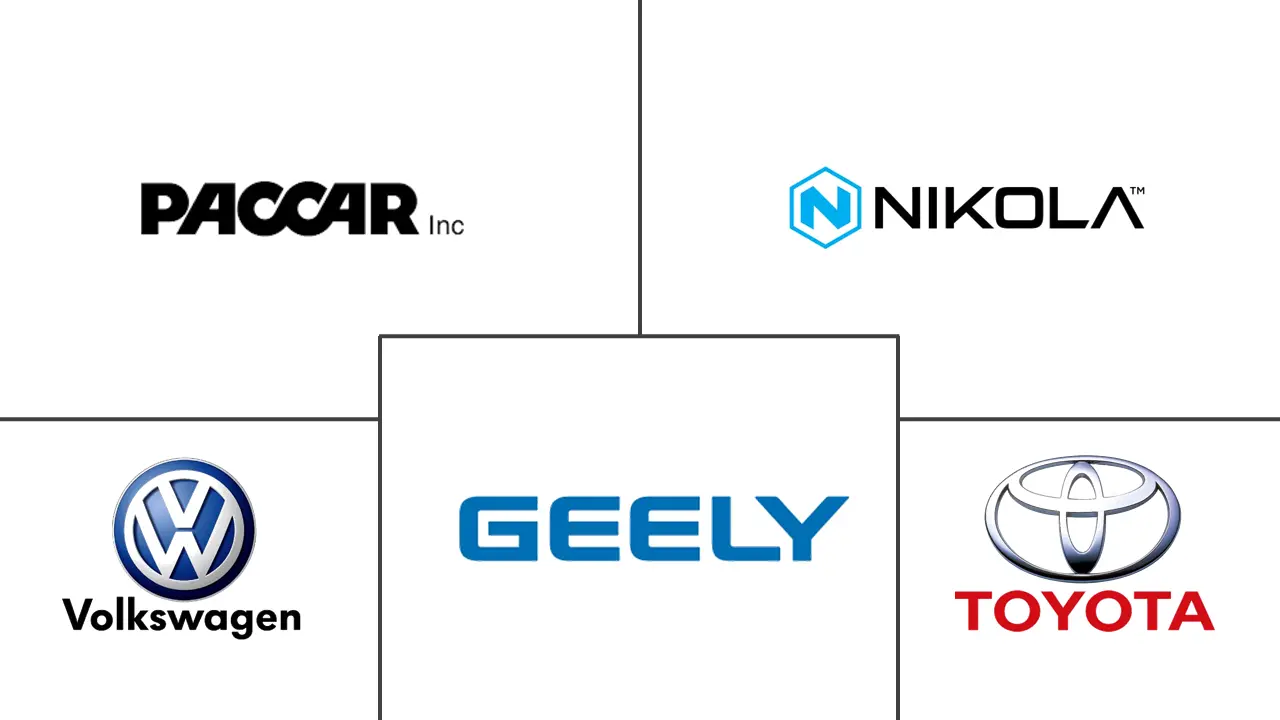
*Disclaimer: Major Players sorted in no particular order |
Fuel Cell Commercial Vehicle Market Analysis
The Fuel Cell Commercial Vehicle Market size is estimated at USD 1.87 billion in 2025, and is expected to reach USD 7.74 billion by 2030, at a CAGR of 32.82% during the forecast period (2025-2030).
Over the long term, the fuel cell commercial market will be driven by the government's enactment of stringent emission norms, growing mass urban transportation, rising demand for alternate fuel vehicles, and increasing investments to enhance hydrogen fuel cell technology. Various governments across the world are increasingly setting emission standards to promote the reduction of carbon emissions. It, in turn, is leading commercial vehicle manufacturers to develop alternative fuel technologies, such as hydrogen fuel cells, which can be incorporated into buses, trucks, and vans, among other vehicles. For instance,
• In August 2022, the Indian government announced a commitment to reduce the Emission Intensity of its GDP by 45% by 2030 compared to 2005 levels. The aggressive policies adopted by the government to tackle carbon emissions are contributing to the surging demand for fuel-cell buses across the country.
• In order to tackle climate change, the European Parliament adopted the European Climate Law, which raises the EU's target of reducing net emissions of greenhouse gas by at least 55% by 2030. From a long-term perspective, the European Union aims to be carbon neutral by the end of 2050.
The fuel cell commercial vehicle market is fairly new compared to the industry's electric and IC engine counterpart markets on a global scale. Due to the early stages of development and production of this technology in vehicles, the market witnessed various incumbents such as Mercedes-Benz, PACCAR, and Toyota, among others, commencing the launch of hydrogen fuel cell commercial vehicles in recent years. However, the market is also witnessing the integration of several entrants, which can change the landscape of the industry through lower-priced offerings than incumbent automakers.
Moreover, buses and trucks have dominated the fuel cell commercial vehicle market, with vans and other light commercial vehicles, such as pickup trucks, only contributing to a smaller share of overall sales worldwide. However, in recent years, various companies have constantly invested hefty sums in their research and development to manufacture fuel cell vans, pickup trucks, and other light commercial vehicles in the market. Such developments are expected to positively impact the demand for fuel-cell commercial vehicles during the forecast period.
• In July 2023, Spectronik, a Singapore-based fuel cell solutions specialist, unveiled the prototype of a van powered by its hydrogen fuel cells system. It can carry up to 1 tonne of cargo. The van includes a range of 500 km and can be refueled rapidly within five minutes, making it a solution that offers environmentally friendly transport and logistics.
With the increasing investments in developing advanced fuel cell technology and the expanding alternative fuel vans and pickup truck demand, the fuel cell commercial market is expected to witness surging growth during the forecast period.
Fuel Cell Commercial Vehicle Market Trends
The Buses Segment of the Market to Witness Surging Growth during the Forecast Period
The integration of fuel cell technology in buses has gained prominence in recent years, with countries such as China, South Korea, and the United States deploying a larger fleet of buses powered by hydrogen fuel cells. Government and private players operating in the industry are extensively focusing on collaboration to develop and ultimately deploy buses as an eco-friendly medium of transportation.
• According to the International Energy Agency, China dominated fuel cell bus sales with a fleet size touching 5,400 units as of 2022, while the fuel cell bus fleet touched 200 and 300 units in the United States and South Korea, respectively.
Furthermore, with the growing concerns over the environment, governments and environmental agencies have been enacting stringent emission norms and laws. They are expected to increase the manufacturing cost of diesel engines over the coming years. As a result, the new bus diesel engine segment is expected to register a sluggish growth rate in the short term, thereby increasing the demand for fuel-cell buses. Most diesel engines can convert about 40-46% of the fuel energy, while the remaining energy is lost into the environment as heat through exhaust emissions and cooling systems. The burden on commercial vehicle manufacturers increased with the enactment of the Euro VI emission for heavy-duty engines.
• In North America, the US GHG emissions and fuel efficiency standards pertaining to heavy and medium-duty vehicles have been developed jointly by the Environmental Protection Agency (EPA) and the National Highway Traffic Safety Administration (NHTSA).
• The NHTSA developed fuel consumption standards under the authority of the 2007 Energy Independence and Security Act (EISA), while the EPA developed a GHG emissions program under the Clean Air Act. In the United States, vehicles such as buses are regulated to achieve up to 27% CO2 emission reductions over the 2017 baselines by 2027.
Various state administrations are placing orders and formulating ambitious plans to deploy a higher number of fuel-cell public vehicles over the coming years. It is expected to positively impact the demand for the fuel cell bus segment of the market during the forecast period.
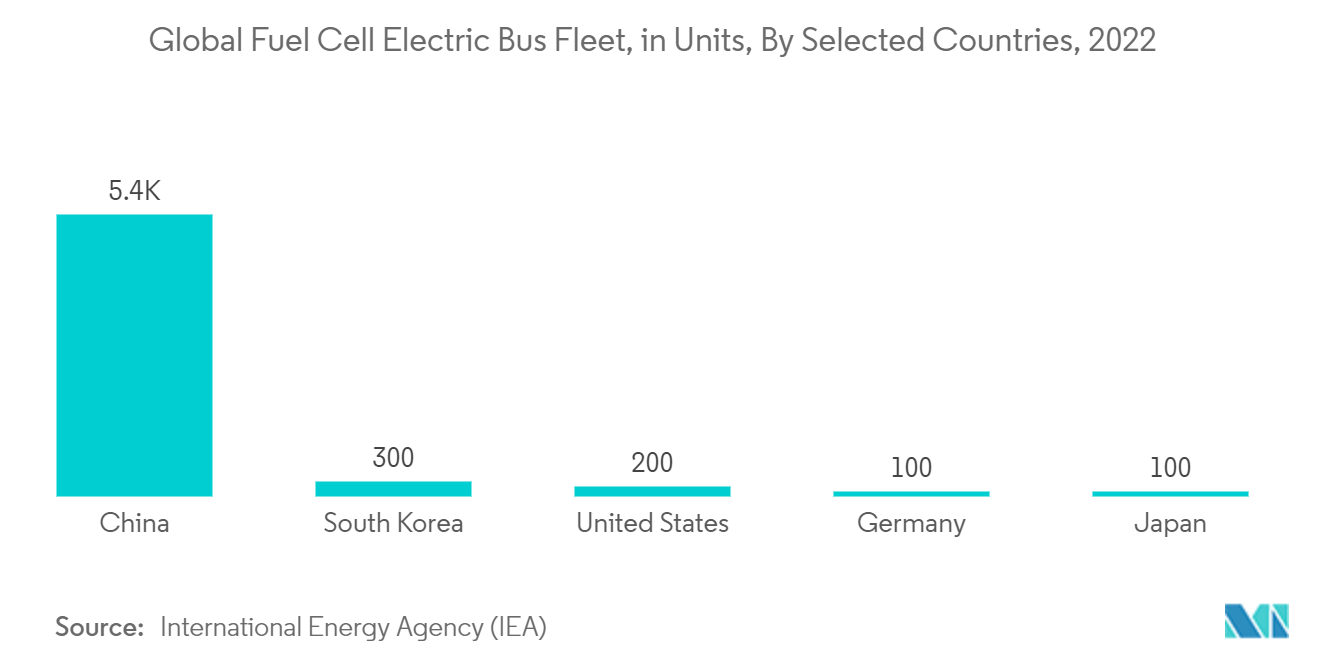
Asia-Pacific to Become the Fastest-growing Regional Market during the Forecast Period
Asia-Pacific is expected to lead the market owing to improvements in public transportation infrastructure in major countries like China, India, Indonesia, and Thailand. The rising urbanization rate and increasing investments in the construction industry aid the demand for alternative trucks and buses in the region. The Asia-Pacific region is also home to major manufacturers of fuel-cell vehicle technology, such as Zhejiang Geely Holding Group, Tata Motors, and Toyota Motor Corporation. These companies are actively engaging in the manufacture of fuel cell buses and trucks that can complement the government's effort to electrify commercial vehicle fleets.
Additionally, several new developments in the way of investments into fuel-cell-powered vehicles are further expected to increase the demand for fuel-cell commercial vehicles in the region. Several major cities and countries have released their goals to reduce commercial vehicle emissions, with plans for hydrogen technology and investments in this industry.
- The Japanese government is banking on hydrogen vehicles to achieve carbon neutrality by 2050. It has set an ambitious target of having 200,000 FCVs on the road by 2025, compared to about 3,600 in 2019, along with 320 hydrogen filling stations under its third Strategic Roadmap for Hydrogen and Fuel Cells.
- Japan-based Toyota and Honda Motor Co. Ltd are the pioneers in commercial passenger hydrogen models. However, South Korean rival Hyundai Motor Co. recently also entered the fray, encouraged by its government's plans to produce 6.2 million FCVs and build at least 1,200 refilling stations by 2040.
The growing investments to develop and enhance hydrogen fueling stations in Asia-Pacific countries are also expected to drive the market's growth.
- According to the United States Department of Energy, China and Japan are the top two countries worldwide constructing the highest number of hydrogen fueling stations. As of 2022, the number of hydrogen fueling stations in China touched 250 units, while in Japan, the number of hydrogen fueling stations touched 161 units during the same period.
With the increasing support of governments and private players to support the adoption of fuel cell technology, Asia-Pacific countries are expected to record surging growth during the forecast period.
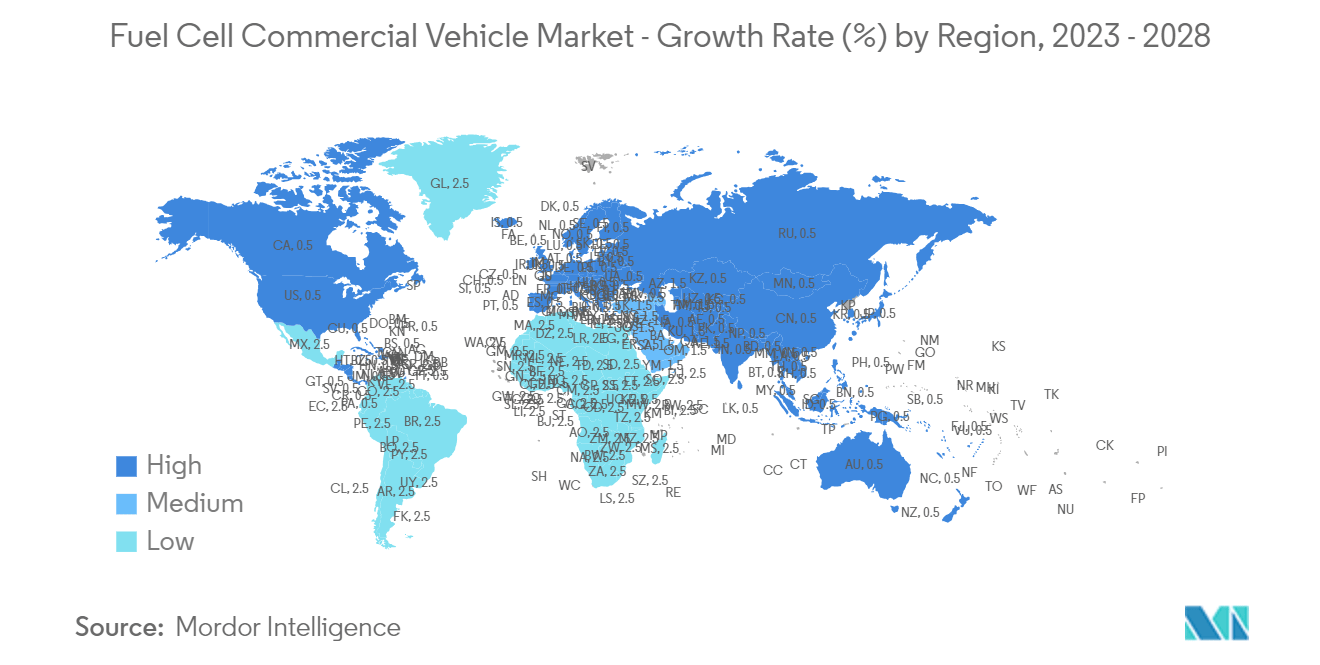
Fuel Cell Commercial Vehicle Industry Overview
The fuel cell commercial vehicle market is fragmented and highly competitive due to the presence of several manufacturers of different capabilities and sizes, including major automakers like Scania, Toyota, etc., and relative entrants to this market segment, including companies like Nikola Motors. Some of the major players include PACCAR Inc., Volkswagen Group, Zhejiang Geely Holding Group Co. Ltd, Honda Motor Company, Mercedes-Benz Group AG, and Hyundai Motor, among others. These players actively seek to engage in partnerships and collaborations with commercial vehicle fleet operators and governments worldwide to market their products and ensure a constant business flow.
- In November 2023, Pure Hydrogen, a company positioning itself as a supplier of both hydrogen-powered vehicles and hydrogen itself, showcased its 220 kW Taurus hydrogen fuel cell truck at Brisbane’s Truck Show. Further, the company stated that the newly designed truck is capable of handling loads of up to 70 tons and possesses a range of 400-600 km.
- In September 2023, Tata Motors announced the delivery of two of its flagship hydrogen fuel cell-powered (FCEV) buses to Indian Oil Corporation Ltd (IOCL), one of the largest petroleum companies in India. The delivery is part of a tender that Tata Motors won in June 2021 to provide 15 FCEV buses. The scope included evaluating the potential of hydrogen-based PEM fuel-cell technology in India.
The market is anticipated to witness the launch of various advanced fuel cell technologies, especially for trucks and buses, as these players try to gain a competitive edge in the industry.
Fuel Cell Commercial Vehicle Market Leaders
-
PACCAR Inc.
-
Nikola Corporation
-
Volkswagen Group (Scania)
-
Zhejiang Geely Holding Group Co., Ltd.
-
Toyota Motor Company
- *Disclaimer: Major Players sorted in no particular order
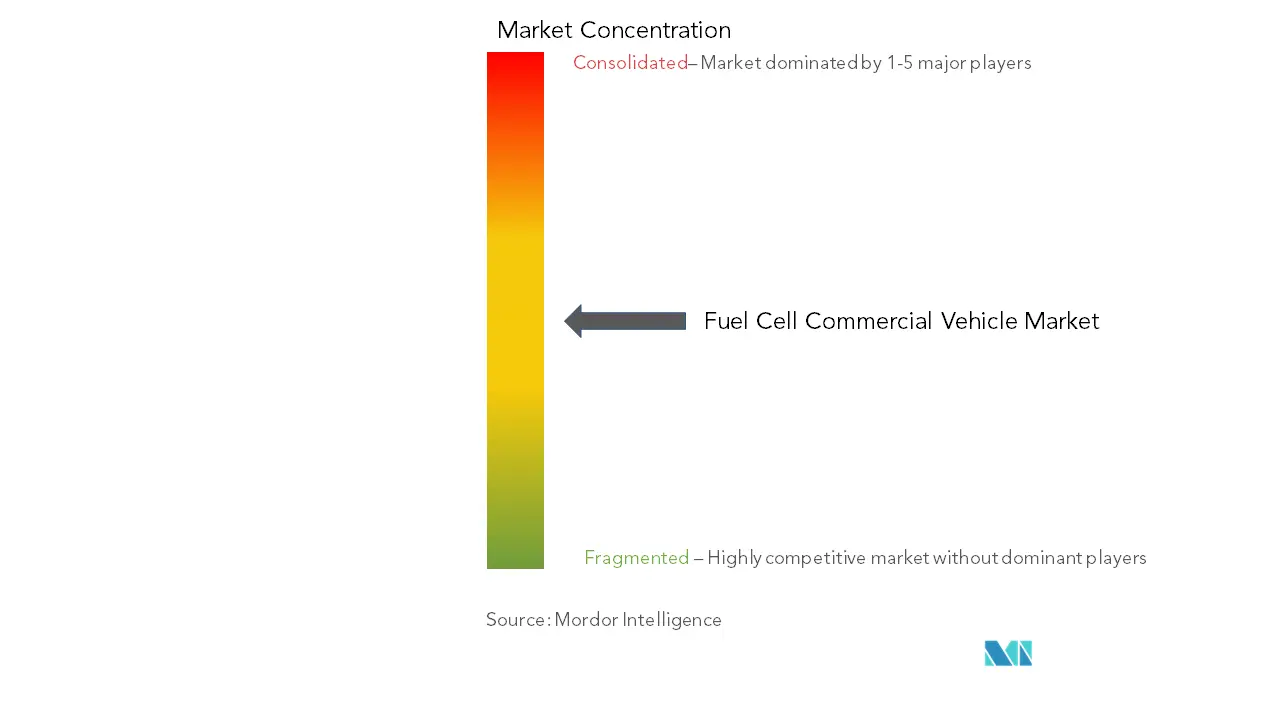
Fuel Cell Commercial Vehicle Market News
- December 2023: General Motors partnered with Autocar Industries to develop a range of zero-emission vocational trucks powered by GM’s HYDROTEC fuel cell technology to offer customers a robust, clean alternative to diesel-powered vehicles. Further, the company stated that the first vehicles are expected to roll off the production line at Autocar’s Birmingham, Alabama, US, plant in 2026. Both these companies are initially planning to focus on integrating fuel cell technology for cement mixers, roll-off, and dump trucks, followed by refuse trucks and terminal tractors.
- December 2023: Toyota Motor Europe announced its plan to establish local business operations for hydrogen-based products in the European continent. The Hydrogen Factory Europe will ensure a coordinated approach to the commercialization of hydrogen technology and systems in the region, ranging from development and production to sales and aftersales of commercial and passenger vehicles. The factory will be responsible for producing fuel cell systems and supporting a wide group of commercial partnerships, which is in line with Toyota’s strategy to achieve carbon neutrality in Europe by 2040.
- August 2023: The Indian government announced the commencement of a commercial trial to offer a hydrogen fuel cell bus service in the union territory of Leh. The project is being implemented by one of the leading power producers in the country, NTPC, supplying five hydrogen fuel cell buses to the Leh administration for an inter-city service in the city. For a successful commercial operation, NTPC also built a refueling station and captive solar plant of 1.7 MW for producing green hydrogen to power these buses.
Fuel Cell Commercial Vehicle Industry Segmentation
Fuel cell commercial vehicles refer to trucks, buses, vans, etc., which utilize a fuel cell, sometimes in combination with a small battery or supercapacitor, to power its onboard electric motor. Fuel cells in commercial vehicles generate electricity generally using oxygen from the air and compressed hydrogen.
The fuel cell commercial vehicle market is segmented by vehicle type, power range, and geography. By vehicle type, the market is segmented into buses, trucks, vans, and other vehicle types (pickup trucks, etc.). By power range, the market is segmented into below 100 kW, 100 kW - 200 kW, and above 200 kW. By geography, the market is segmented into North America, Europe, Asia-Pacific, and the Rest of the World.
The report offers market size and forecasts for fuel cell commercial vehicles in value (USD) and volume (units) for all the above segments.
| By Vehicle Type | Buses | ||
| Trucks | |||
| Vans | |||
| Other Vehicle Types (Pickup Trucks, etc.) | |||
| By Power Range | Below 100 kW | ||
| 100 kW - 200 kW | |||
| Above 200 kW | |||
| By Geography | North America | United States | |
| Canada | |||
| Rest of North America | |||
| Europe | Germany | ||
| United Kingdom | |||
| France | |||
| Italy | |||
| Rest of Europe | |||
| Asia-Pacific | China | ||
| India | |||
| Japan | |||
| South Korea | |||
| Rest of Asia-Pacific | |||
| Rest of the World | South America | ||
| Middle East and Africa | |||
Fuel Cell Commercial Vehicle Market Research FAQs
How big is the Fuel Cell Commercial Vehicle Market?
The Fuel Cell Commercial Vehicle Market size is expected to reach USD 1.87 billion in 2025 and grow at a CAGR of 32.82% to reach USD 7.74 billion by 2030.
What is the current Fuel Cell Commercial Vehicle Market size?
In 2025, the Fuel Cell Commercial Vehicle Market size is expected to reach USD 1.87 billion.
Who are the key players in Fuel Cell Commercial Vehicle Market?
PACCAR Inc., Nikola Corporation, Volkswagen Group (Scania), Zhejiang Geely Holding Group Co., Ltd. and Toyota Motor Company are the major companies operating in the Fuel Cell Commercial Vehicle Market.
Which is the fastest growing region in Fuel Cell Commercial Vehicle Market?
Asia-Pacific is estimated to grow at the highest CAGR over the forecast period (2025-2030).
Which region has the biggest share in Fuel Cell Commercial Vehicle Market?
In 2025, the Asia-Pacific accounts for the largest market share in Fuel Cell Commercial Vehicle Market.
What years does this Fuel Cell Commercial Vehicle Market cover, and what was the market size in 2024?
In 2024, the Fuel Cell Commercial Vehicle Market size was estimated at USD 1.26 billion. The report covers the Fuel Cell Commercial Vehicle Market historical market size for years: 2019, 2020, 2021, 2022, 2023 and 2024. The report also forecasts the Fuel Cell Commercial Vehicle Market size for years: 2025, 2026, 2027, 2028, 2029 and 2030.
Our Best Selling Reports
Fuel Cell Commercial Vehicles Industry Report
Statistics for the 2025 Fuel Cell Commercial Vehicle market share, size and revenue growth rate, created by Mordor Intelligence™ Industry Reports. Fuel Cell Commercial Vehicle analysis includes a market forecast outlook for 2025 to 2030 and historical overview. Get a sample of this industry analysis as a free report PDF download.




